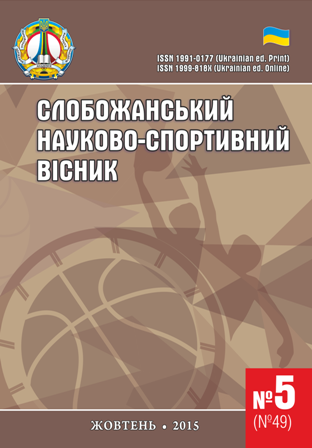Контроль параметрів уваги у баскетболістів на етапі попередньої базової підготовки
DOI:
https://doi.org/10.15391/snsv.2015-5.012Ключові слова:
юні баскетболісти, етап попередньої базової підготовки, контроль параметрів уваги, техніко-тактичні діїАнотація
Мета: визначити параметри уваги у баскетболістів 13–14 років до та після фізичного навантаження різної спрямованості. Матеріал і методи: у дослідженні прийняло участь три команди баскетболістів 13–14 років навчально-тренувальних груп. Загальна кількість досліджуваних 50 осіб. Дослідження проводилось на базі СДЮСШОР № 5 м. Дніпропетровськ. Використовувались методи теоретичного аналізу й узагальнення літературних джерел, метод аналізу документальних матеріалів, педагогічне спостереження, психологічне тестування, пульсометрія, методи математичної статистики. Для визначення параметрів уваги використовувались такі методики: «Переплутані лінії», коректурна проба з кільцями Ландольдта, коректурна проба з літерами. Результати: виявлено в ході проведеного нами дослідження переважно низький рівень розвитку параметрів уваги у баскетболістів на етапі попередньої базової підготовки. Визначено, що на зниження параметрів уваги переважно впливає навантаження специфічного характеру, особливо понижуються показники концентрації, переключення, стійкості, збільшується кількість помилок. Висновки: на основі проведених досліджень виникає необхідність вдосконалення системи контролю в ДЮСШ з включенням тестів щодо визначення компонентів психологічної підготовленостіПосилання
Artemenko T. G. Vіdbіr basketbolіstіv na yetapі pochatkovoі pіdgotovki z urakhuvannyam іkh osobistіsnikh osoblivostey: avtoref. dis. kand. nauk. z fіz.vikh. і sportu : spets. 24.00.01 «Olіmpіyskiy і profesіyniy sport» [Selection of basketball players at the stage of initial training based on their personal characteristics : PhD thesis], Kiіv, 2010, 20 p. (ukr)
Voronova V. І . Psikhologіya sportu : Navch. posіbnik dlya vishchikh navch. zakladіv [Sports Psychology], Kiіv, 2007, 272 p. (ukr)
Mіtova O. O., Іvchenko O. M. Sportivniy vіsnik Pridnіprov’ya. Naukovo-praktichniy zhurnal [Sports Bulletin Dnieper], vol. 3, 2014, p. 72–76. (ukr)
Orekhov L. I., Karavayeva Ye. L., Asmolova L. A. Mirovyye standarty planirovaniya eksperimentov i statisticheskoy obrabotki v pedagogike, psikhologii i fizicheskoy kulture [Global standards of design of experiments and statistical processing in pedagogy, psychology and physical education], Almaty, KazAST, 2009, 210 p. (rus)
Platonov V. N. Sistema podgotovki sportsmenov v olimpiyskom sporte : Obshchaya teoriya i yeye prakticheskiye prilozheniya [The system of training athletes in Olympic sports. The general theory and its practical application], Kyiv, 2004, 806 p. (rus)
Samoylov N. G. Slobozans’kij nauk.-sport. visn. [Slobozhanskyi science and sport bulletin], Kharkіv, 2011, p. 158–162. (rus)
Tsimbalyuk Zh. O. Vpliv osnovnikh vlastivostey nervovoі sistemi na rozvitok taktichnogo mislennya yunikh basketbolіstok : avtoref. dis. … kand. nauk. z FVіS : spets. 24.00.01 «Olіmpіyskiy ta profesіyniy sport» [The influence of the basic properties of the nervous system in the development of tactical thinking young basketball players : PhD thesis], Kharkіv, 2004, 24 p. (ukr)
Shutova S. Е. Fizicheskoye vospitaniye studentov tvorcheskikh spetsialnostey [Physical training of students of creative specialties], Kharkov, 1999, vol. 2, p. 8–12. (rus)
Shinkaruk O. A. Sportivniy vіsnik Pridnіprov’ya [Sports Bulletin Dnieper], 2014, p. 191–198.
Burton D. Sport psychology for coaches / D. Burton, T. D. Readeke. – Champaign : Human Kinetics, 2009. – 292 p.
##submission.downloads##
Опубліковано
Як цитувати
Номер
Розділ
Ліцензія
Авторське право (c) 2015 (Olena Mitova) Мітова Олена Олександрівна, (Oksana Ivchenko) Івченко Оксана Миколаївна

Ця робота ліцензується відповідно до Creative Commons Attribution 4.0 International License.
Наше видання використовує положення про авторські права CREATIVE COMMONS для журналів відкритого доступу.
Автори, які публікуються у цьому журналі, погоджуються з наступними умовами:
1. Автори залишають за собою право на авторство своєї роботи та передають журналу право першої публікації цієї роботи на умовах ліцензії Creative Commons Attribution License, котра дозволяє іншим особам вільно розповсюджувати опубліковану роботу з обов'язковим посиланням на авторів оригінальної роботи та першу публікацію роботи у цьому журналі.
2. Автори мають право укладати самостійні додаткові угоди щодо неексклюзивного розповсюдження роботи у тому вигляді, в якому вона була опублікована цим журналом (наприклад, розміщувати роботу в електронному сховищі установи або публікувати у складі монографії), за умови збереження посилання на першу публікацію роботи у цьому журналі.

 До уваги авторів!
До уваги авторів!


